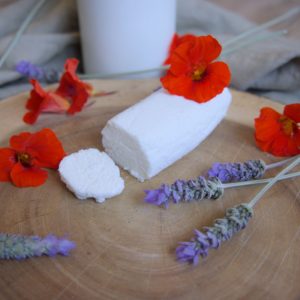
Simple Goat Cheese
This simple recipe uses only 3 easy-to-find ingredients and doesn’t require culturing. You'll get a delicious goat cheese that's mild in flavor, creamy or crumbly in texture, and brings out the subtle, natural tang of goat milk.
Equipment
- Dutch oven or stainless steel pot
- cheesecloth
- instant-read thermometer
- strainer
- large bowl
Ingredients
- 8 c goat milk 2 quarts
- 1.5 tsp citric acid or ⅔ c lemon juice or ½ c vinegar
- ¼ c water
- 1 tsp salt non-iodized
Instructions
- Add the citric acid to ¼ c cool water and stir until it has dissolved.
- Pour the goat milk into a large pot on the stove, add the dissolved citric acid, and stir it gently but thoroughly to combine.
- Heat the pot of milk over medium-low, stirring frequently to prevent scorching, until it reaches 190 ℉.
- Remove the pot from heat. If you are using lemon juice or vinegar instead of citric acid, now is the time to add them (no need to include the ¼ c of water), stirring in thoroughly. Place the lid on the pot and let it sit for 15 minutes while the curds separate from the whey.
- Line a strainer or colander with a double layer of cheesecloth and place it over a bowl that will be able to catch the draining whey liquid. Pour the mixture into the lined strainer.
- Allow your curds to drain for 2-8 hours, depending on how spreadable or crumbly you would like them. The longer you allow the curds to drain, the less whey they will contain and the more crumbly the cheese will be. To make a cheese log, somewhere between 4-6 hours is the sweet spot for us.
- Add salt and any desired seasonings to your cheese and stir in gently with a spoon. You can do this right in the cheesecloth-lined strainer or in a separate small bowl you've scraped your cheese into.
- If forming your cheese into a log, place it in a clump on a piece of beeswax wrap or plastic wrap. Use the wrap to roll the cheese into form. Twist the ends closed around the log shape. Be gentle when rolling your log so as not to smear the cheese, but make sure to give it enough pressure to remove any air gaps.
- Allow your cheese to set in the fridge for at least an hour. Enjoy!
Notes
- Raw goat milk and regular pasteurized goat milk are the most reliable forms of milk for this cheese.
- See the blog post for optional savory and sweet ingredient add-ins.